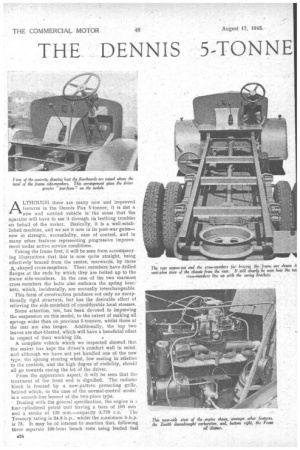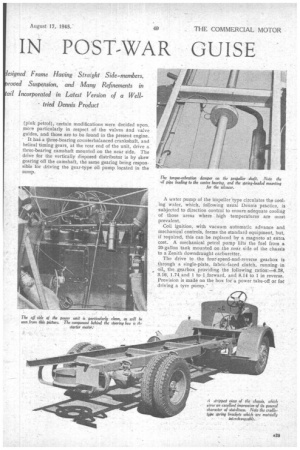THE DENNIS 5-TONNE IN POST-WAR GUISE
Page 26

Page 27

Page 28

If you've noticed an error in this article please click here to report it so we can fix it.
esignecl Frame Having Straight Side-members, roved Suspension, and Many Refinements in all Incorporated in Latest Version of a Well/tied Dennis Product
ALTHOLTGII there are many new and improved
, features in the Dennis Pax 5-tonner, it is not a new and untried vehicle in the sense that the operator will have to see it through. its teething troubles on behalf of the maker. Basically, it is a well-established machine, and we see it now in its post-war guise— new in strength, accessibility, ease of control, and in many other features representing progressive improve merit under active service conditions.
faking the frame first, it will be seen from accompanying illustrations that this is now quite straight, being effectively braced from the centre, rearwards, by three j-L-shaped cross-members.' These members have drilled flanges at the ends by which they are bolted up to the frame side-members. . In the case of the two rearmost cross-members the bolts also embrace the spring brackets, which, incidentally, are mutually interchangeable.
This form of construction produces not only an exceptionally rigid structure, but has the desirable effect of relieving the side-members of considerable local stresses.
Some attention, too, has been devoted to improving the suspension on this model, to the extent of making all springs wider than on previous 5-tormers, whilst those at the rear are also longer. Additionally, the top two leaves are shot-blasted, which will have a beneficial effect in respect of their working life. a • A complete ,vehicle which we inspected showed that the maker has kept the driver's comfort well in mind. and although we have not yet handled one of the new type, the sprung steering wheel, low seating in relation to the controls, and the high degree of visibility, should all go towards casing the lot of the driver.
From the appearance aspect, it will be seen that the treatment of the front end is dignified. The radiator block is fronted by a new-pattern protecting grille, behind which, in the case of the normal-control model is a smooth-line bonnet of the two-piece type.
' Dealing with the general specification, the engine is a tour-cylindered petrol unit having a bore of 100 mm
and a stroke of 120 min.—capacity 3,770 c.c. The Treasury rating is 24.8 hp., whilst the n.axirnum b.h.p. is 75: It may be of interest to mention that, following three separate 100-hour bench tests :using leaded fuel
(Pink petrol), certain modifications were decided upon. more particularly in respect of the valves and valve guides, and those are to be found in the present engine.
It has a three-bearing counterbalanced crankshaft, and helical timing gears, at the rear end of the unit, drive a three-bearing camshaft mounted on the near side. The drive for the vertically disposed distributor is by skew gearing off the camshaft, the same gearing being responsible for driving the gear-type oil pump located in the sump.
A water pump of the impeller type circulates the cooling water, which, following usual Dennis practice, is subjected to direction control to ensure adequate cooling of those areas where high temperatures are most prevalent.
Coil ignition, with vacuum automatic advance and mechanical controls, forms the standard equipment, but, if required, this can be replaced by a magneto at extra cost. A mechanical petrol pump lifts the fuel from a 20-gallon tank mounted on the near side of the chassis to a Zenith clowndraught carburetter.
The drive to the four-speed-and-reverse gearbox is through a single-plate, fabric-faced clutch, running in oil, the gearbox providing the following ratios:-8.28, 3.16, 1.74 and 1 to 1 forward, and 8.14 to 1 in reverse. Provision is made on the box for a power take-off or for driving a tyre pump.'
The complete engine and gearbox unit is threepoint mounted on rubber. At the rear of the unit is a semicircular bracket, secured to a cross-member, that passes under the after end of the gearbox which it supports on a rubber pad, a single spring-loaded bolt acting as a locator. Forward, there are two steel cradles, so bonded to rubber, as to give a fully floating effect.
Fitted to the rear of the engine is a torquereaction member, rubber-cushion-mounted on to the off-side frame member. Clutch actuation is via relay linkage, which is necessitated by the relationship of the clutch pedal position to the arm of the clutch-actuating shaft.
A two-piece open propeller shaft, incorporating a torque vibration damper, conveys the drive to the rear axle, the centre bearing being so mounted as to bring the shaft beneath the Chassis cross-member., The centre casing of the vertical banjo-type rear axle is in steel with the housings for the axle shafts pressed-in and welded. Spiral bevel gears having a ratio of 7 to 1 are used, and the axle shafts are fully floating.
On the wheel side of the spring mountings, the front axle assumes a rounded section to give increased resistance against brake reaction effects. As previously mentioned, the semi-elliptic springs are now wider, the present dimensions being ; front 2i ins, and rear 3 ins. The front springs are 41 ins, long and those at the rear have been increased to 54 ins.
All springs are mounted above the axles and are held to the spring pads by inclined U bolts. A rubber buffer, between spring and frame, is provided on each front spring to act as a cushion under conditions which may cause excessive spring deflection. Brake drums are 16 ins, in diameter and house 3i-in. wide shoes in the rear, and 21-in. wide shoes in the front. These are of the Girling two-leading-shoe type, operated by taper and roller expanders, on the Lockheed hydraulic system. The brake-operating cylinders are arranged on -the outside of the drums and are thus effectively cooled. The master cylinder is bolted to the' chassis frame on -the off side just forward of the battery cradle.
Open-type pressed-steel disc wheels are equipped with • 34-in. by 7 -in. tyres, with, of course, twins at the rear. A 12-volt dynamo is mounted on the near side of the engine, where it is driven by a V-belt off the crankshaft, the same belt driving the cooling fan.
, The following are the general dimensions of the Dennis Fax 5-tonner, both as a normal-control and forward-control chassis, figures relative to the latter, where they differ from the former, being given in parentheses:— Wheelbase, 12 ft. 10 ins.; overall length, 22 ft. '31 ins. (22 ft. 5 ins.); overall .width, 7 ft.; wheel track, front 5 ft. 11* ins.;wheel track, rear, 5 ft. 4 ins.; back -if clb to end of frame, 15 ft. 2 ins. (17 ft. 10 ins.); turning circle, approximately 49 ft.; approximate weight of ehassiss2 tons 3 cwt. (2 tons n cwt.). The maker is Dennis Bros., Ltd . , Gu ford, Surrey.




















































